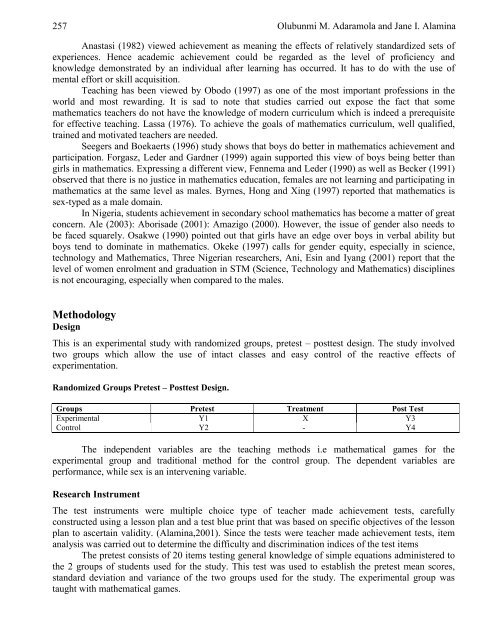European Journal of Scientific Research - EuroJournals
European Journal of Scientific Research - EuroJournals
European Journal of Scientific Research - EuroJournals
You also want an ePaper? Increase the reach of your titles
YUMPU automatically turns print PDFs into web optimized ePapers that Google loves.
257 Olubunmi M. Adaramola and Jane I. Alamina<br />
Anastasi (1982) viewed achievement as meaning the effects <strong>of</strong> relatively standardized sets <strong>of</strong><br />
experiences. Hence academic achievement could be regarded as the level <strong>of</strong> pr<strong>of</strong>iciency and<br />
knowledge demonstrated by an individual after learning has occurred. It has to do with the use <strong>of</strong><br />
mental effort or skill acquisition.<br />
Teaching has been viewed by Obodo (1997) as one <strong>of</strong> the most important pr<strong>of</strong>essions in the<br />
world and most rewarding. It is sad to note that studies carried out expose the fact that some<br />
mathematics teachers do not have the knowledge <strong>of</strong> modern curriculum which is indeed a prerequisite<br />
for effective teaching. Lassa (1976). To achieve the goals <strong>of</strong> mathematics curriculum, well qualified,<br />
trained and motivated teachers are needed.<br />
Seegers and Boekaerts (1996) study shows that boys do better in mathematics achievement and<br />
participation. Forgasz, Leder and Gardner (1999) again supported this view <strong>of</strong> boys being better than<br />
girls in mathematics. Expressing a different view, Fennema and Leder (1990) as well as Becker (1991)<br />
observed that there is no justice in mathematics education, females are not learning and participating in<br />
mathematics at the same level as males. Byrnes, Hong and Xing (1997) reported that mathematics is<br />
sex-typed as a male domain.<br />
In Nigeria, students achievement in secondary school mathematics has become a matter <strong>of</strong> great<br />
concern. Ale (2003): Aborisade (2001): Amazigo (2000). However, the issue <strong>of</strong> gender also needs to<br />
be faced squarely. Osakwe (1990) pointed out that girls have an edge over boys in verbal ability but<br />
boys tend to dominate in mathematics. Okeke (1997) calls for gender equity, especially in science,<br />
technology and Mathematics, Three Nigerian researchers, Ani, Esin and Iyang (2001) report that the<br />
level <strong>of</strong> women enrolment and graduation in STM (Science, Technology and Mathematics) disciplines<br />
is not encouraging, especially when compared to the males.<br />
Methodology<br />
Design<br />
This is an experimental study with randomized groups, pretest – posttest design. The study involved<br />
two groups which allow the use <strong>of</strong> intact classes and easy control <strong>of</strong> the reactive effects <strong>of</strong><br />
experimentation.<br />
Randomized Groups Pretest – Posttest Design.<br />
Groups Pretest Treatment Post Test<br />
Experimental Y1 X Y3<br />
Control Y2 - Y4<br />
The independent variables are the teaching methods i.e mathematical games for the<br />
experimental group and traditional method for the control group. The dependent variables are<br />
performance, while sex is an intervening variable.<br />
<strong>Research</strong> Instrument<br />
The test instruments were multiple choice type <strong>of</strong> teacher made achievement tests, carefully<br />
constructed using a lesson plan and a test blue print that was based on specific objectives <strong>of</strong> the lesson<br />
plan to ascertain validity. (Alamina,2001). Since the tests were teacher made achievement tests, item<br />
analysis was carried out to determine the difficulty and discrimination indices <strong>of</strong> the test items<br />
The pretest consists <strong>of</strong> 20 items testing general knowledge <strong>of</strong> simple equations administered to<br />
the 2 groups <strong>of</strong> students used for the study. This test was used to establish the pretest mean scores,<br />
standard deviation and variance <strong>of</strong> the two groups used for the study. The experimental group was<br />
taught with mathematical games.

















